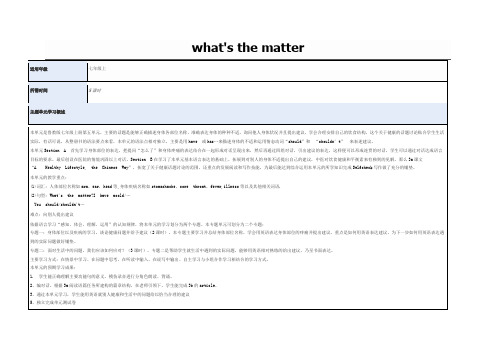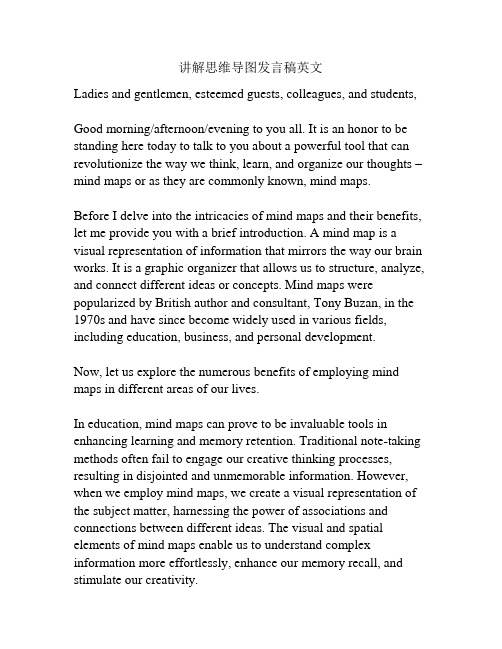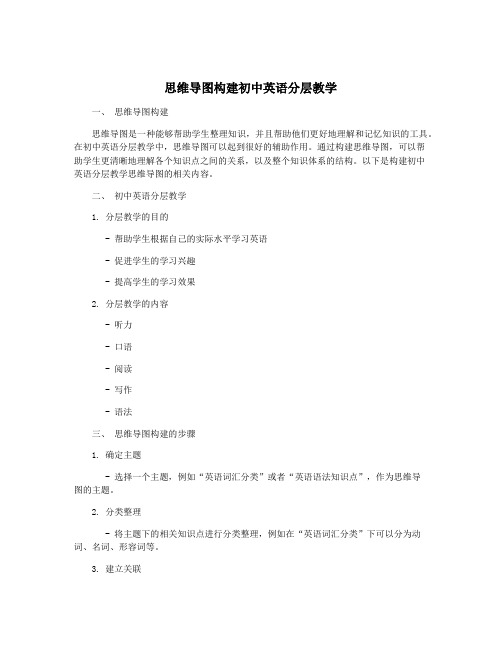中学英语思维导图讲课讲稿
初中英语 译林牛津版七年级上下册知识梳理—思维导图课件

7A
重 点 点 睛
13
7A
重 点 点 睛
14
7A
重 点 点 睛
15
7A重点点睛
16
7A重点点睛
17
7A重点点睛
18
7B教材目录
Grade
Unit
Reading
Unit 1 Dream homes
Homes around
Task
My dream home
Grammar 1. 基数词2.序数词
行为动词的一般现在时(主谓一致、第三 人称单数规则、否定形式、一般疑问句、 区分助动词do和行为动词do的用法)
一般现 在时
Unit 3 Welcom Welcome to e to our our school ! school !
My school 人称代词(主格和宾格)
Unit 4 My day
Designing clothes
1. 用some和any表示数量2. There be结构(就近原则)
现在进行时(1.提示标志2.不用于现 在进行时的动词3.动词的现在分词构 成规则4.现在进行时的否定句、一般
疑问句和特殊疑问句)
现在进 行时
9
03
单元重点点睛
10
7A
重 点 点 睛
11
7A重点点睛
特殊疑问句
Unit 6 Food
and
Keeping fit
lifestyle
Healthy lifestyle
可数名词和不可数名词(可数名词复 数形式变化规则)
Unit 7 Shopping
Unit 8 Fashion
Going shopping
人教版九年级英语各单元主题思维导图(1-10)

阅读篇-Section B 2b
The Spirit of Christmas
Sharing and giving love and joy
The Best Example: A Christmas Carol (a novel by Charles Dickens)
three ghosts 1. the Ghost of... Past 2. the Ghost of... Present 3. the Ghost of... Yet to Come
Ways of celebration
(have) sweet dumplings watch the races enjoy/share the mooncakes(with ...) admire the moon throw water at each other wash away bad things celebrate Christmas (with..) give gifts to people in need treat everyone with kindness and warmth spread love and joy
初中英语人教版九年级全一册
Unit3 Could you please tell me where the restrooms are?
单元主题思维导图
阅读篇-Section B 2b
How to ask for help politely
In different situations, choose and use suitable language based on.
by working with friends /a group by writing e-mails to pen pals take notes by writing down key words or by drawing mind maps Maybe you should join an English club. Don't read word for word. Read word groups. Be patient. It takes time. Practice makes perfect.
思维导图破解初中英语语法:书面表达(PPT讲解)

初中英语高效学习
答案1
Ladies and gentlemen, Good evening! It's really a great honor for me to speak here. I extremely appreciate your invitation and reception.
To start with, I sincerely hope more chances will be given to exchange our culture, customs , innovations and inventions in the near future. What’s more, it's known that China possesses a
People in our country attach such great importance Chinese red that they use many red objects in some important events. For instance, in a wedding, you can see that the bride is in a red wedding dress and the wedding room is decorated with red. What's more, the houses are also filled with red paper cuts, lanterns and Chinese Knots during the Spring Festival. Children will get red pockets for best wishes as well. Obviously, Chinese red plays a significant role and enjoys the highest popularity in China.
高中英语思维导图课件

提高记忆效率
02
通过思维导图将单词与图像、故事等元素相连接,提高学生的
记忆效率和兴趣。
培养自主学习能力
03
学生可以利用思维导图自主整理和复习单词,培养自主学习的
能力和习惯。
思维导图在英语语法教学中的应用
清晰呈现语法规则
思维导图可以清晰地呈现语法规则,帮助学生更 好地理解和记忆。
增强语感
通过思维导图的训练,学生可以在实践中增强语 感,提高语法使用的准确性。
突出重点和难点
对于重点和难点内容,可以使用特殊符号 或标注进行强调。
注意排版和布局
思维导图的排版和布局要合理,保持清晰 整洁的整体形象。
避免信息重复
思维导图中避免出现信息的重复表达,尽 量精简内容,突出核心概念。
05
思维导图课件的效果评估
对思维导图的评估方法
学生反馈
教师反馈
与学生进行沟通,了解他们对思维导图课件 的看法和感受,以及他们对思维导图课件是 否符合学习需求的意见和建议。
3
本次课件旨在推广思维导图在高中英语教学中 的应用
思维导图的意义和应用
思维导图的定义和 特点
思维导图在英语学 科中的重要性及应 用方法
思维导图在学科中 的应用及效果
02
思维导图英语教学
思维导图在英语词汇教学中的应用
建立单词间的联系
01
使用思维导图将单词按照一定的关系进行归类和整理,帮助学
生系统地掌握词汇。
列出主要节点
确定思维导图的中心主题和主要内容。
根据中心主题列出主要节点和子节点。
绘制思维导图
美化思维导图
根据节点之间的关系绘制思维导图,标注连 接线和箭头。
对思维导图进行美化,使其更具吸引力和可 读性。
初中英语《what's the matter》主题单元教学设计以及思维导图

主题单元规划思维导图主题单元学习目标(说明:依据新课程标准要求描述学生在本主题单元学习中所要达到的主要目标)1、知识与技能:a.词汇:人体部位名称如arm,ear,head等,身体疾病名称如stomachache,sore throat,fever,illness 等以及其他相关词语。
b.句型:What's the matter?I have acold/…You should/shouldn't…c.能掌握询问疾病与表示身体不适的话语d.能够针对别人的健康问题并给出合理建议2、过程与方法:在听读的基础上创设语言情景,加强说写能力的训练。
此外,还要充分借用课本描图来丰富学生的写作知识,以提高其写作水平3、情感态度与价值观:通过询问病情与提供合理建议,培养关心他人、助人为乐的美德。
对应课标(说明:学科课程标准对本单元学习的要求)为达成本专题的学习目标,设计以下教学活动:1.创设问题情景,导入阅读文段:师生对话,导入新课:A: What’s the matter?B: I’m not feeling well. I have a stomachache.A: When did it start?B: About _____ ago.A: That’s too bad. You should lie down and rest.B: Yes, I think so.A: I hope you feel better soon.完成1a 和1b:Match the words with the pictures below and match the advice with the people below.听力巩固:What problems do the students have? Write the problems in the chart. Listen again and complete the chart.拓展运用:Make dialogues or give a short report accoding to the chart.2.开展阅读活动,实现生本对话。
讲解思维导图发言稿英文

讲解思维导图发言稿英文Ladies and gentlemen, esteemed guests, colleagues, and students,Good morning/afternoon/evening to you all. It is an honor to be standing here today to talk to you about a powerful tool that can revolutionize the way we think, learn, and organize our thoughts –mind maps or as they are commonly known, mind maps.Before I delve into the intricacies of mind maps and their benefits, let me provide you with a brief introduction. A mind map is a visual representation of information that mirrors the way our brain works. It is a graphic organizer that allows us to structure, analyze, and connect different ideas or concepts. Mind maps were popularized by British author and consultant, Tony Buzan, in the 1970s and have since become widely used in various fields, including education, business, and personal development.Now, let us explore the numerous benefits of employing mind maps in different areas of our lives.In education, mind maps can prove to be invaluable tools in enhancing learning and memory retention. Traditional note-taking methods often fail to engage our creative thinking processes, resulting in disjointed and unmemorable information. However, when we employ mind maps, we create a visual representation of the subject matter, harnessing the power of associations and connections between different ideas. The visual and spatial elements of mind maps enable us to understand complex information more effortlessly, enhance our memory recall, and stimulate our creativity.Moreover, mind maps can be excellent organizational tools for planning and problem-solving tasks. Whether you are a student preparing for an exam, an entrepreneur setting goals for your business, or an individual managing personal projects, mind maps can help streamline your thought processes. By visually mapping out different possibilities, connecting them, and prioritizing them, mind maps enable us to achieve a clearer understanding of our objectives and formulate effective action plans.Furthermore, mind maps can be utilized to foster creativity and brainstorming sessions. By capturing ideas visually and allowing for free association of thoughts, mind maps encourage unconventional thinking and promote original ideas. The hierarchical structure of mind maps facilitates the exploration of connections between disparate concepts and encourages the synthesis of new and innovative solutions.In addition to their educational and organizational benefits, mind maps can also be utilized in various professional settings. For instance, in business meetings, mind maps can assist in improving communication and collaboration. With the help of mind maps, participants can visually represent their ideas, ensuring that everyone has a clear understanding of the topic being discussed. The visual nature of mind maps also makes it easier to identify gaps in information, generate new insights, and reach a consensus as a team.Moreover, mind maps can be employed in project management to streamline complex processes and enhance productivity. Bycreating a visual representation of tasks, deadlines, and dependencies, mind maps help teams stay organized, prioritize their activities, and ensure smooth workflow. Mind maps can serve as a holistic overview of project progress, enabling teams to identify potential bottlenecks and take necessary steps to overcome them.Lastly, mind maps can be harnessed for personal development and self-improvement. By using mind maps as a reflective tool, individuals can gain a deeper understanding of their own thoughts, emotions, and aspirations. Mind maps aid in clarifying personal goals, identifying areas for growth, and devising actionable plans for self-improvement. By mapping out our dreams, ambitions, and personal values, we can gain clarity on the steps required to bring them to fruition.In conclusion, mind maps are a transformative tool that can revolutionize the way we think, learn, and organize our thoughts. By creating visual representations of information, mind maps engage our creative thinking processes, facilitate memory retention, and promote innovative problem-solving. Whether used in education, business, or personal development, mind maps have the potential to improve productivity, enhance communication and foster creativity. So, let us embrace the power of mind maps and unlock our full cognitive potential.Thank you for your attention.。
用思维导图背英语课文讲课稿

• 提示:这里把关键词用红色的标示出来。
• 一篇文章关键词提取出后,就很简单了,剩下了 这些
• brother?
• Australia, six months? • engineer, a big firm? • different places, Australia? • buy an Australian car, go to Alice springs, a small
实例1:
• An exciting trip 激动人心的旅行 • I have just received a letter from my brother, Tim.
He is in Australia. He has been there for six months. Tim is an engineer. He is working for a big firm and he has already visited a great number of different places in Australia. He has just bought an Australian car and has gone to Alice springs, a small town in the centre of Australia. He will soon visit Darwin. From there, he will fly to Perth. My brother has never been abroad before, so he is finding this trip very exciting.
准备材料
• 积极主动思考的大脑,铅笔、橡皮、马克笔或 彩铅笔、A4纸一张
初中英语九年级思维导图词汇学习课程纲要

思维导图既心 智导图,是表达发 散性思维的有效图 形思维工具,它本 质在于化繁为简, 以简驭繁。本课程 可培养学生的逻辑 思维及发散性。
通过思维导 图学习词汇,了 解和学习西方文 化的中的衣食住 行、风土人情、 兴趣爱好、以及 中外文化差异等 方面。
课程基本 理念
发音
管理 自己
交流
认识 反思 自己
内省
词性/词义等
造句
编写单
语言
元故事
导图
பைடு நூலகம்
分工 合作
人际
多元 智能
实操
复述
导图 绘制
小组
逻辑
导图
展示
修改
根据当堂所学词汇,合 理编写单元故事。
以英语学科核心素养为支 撑,发挥课程育人功能。
要素学习与体验学习相呼 应,体现语言学习的实践 性和应用性。
结合教材单元话题,充分 整合课程学习资源。
课程目标
本课程的总目标是:以初中英语核心素养为 支撑、以单元话题为线索、以小组合作为载体, 通过词性、词义、常用、短语、例句,培养学生 的文化品格、学习能力于思维品质、语言能力等 素养,以达到兴趣培养、思维培养、习惯培养的 课程目标。
初中英语思维导图词汇学习课程目标
课程内容
课程核心素养
课程目标
词性 词义 常用
短语 例句
文化品格
学习能力 思维品质
语言能力
兴趣培养 思维培养 习惯培养
教学的 建议
以单元话题为线索,系统 推进初中英语思维导图词 汇课程。
以小组合作为载体,积极 鼓励学生参与课堂。
以核心素养为支撑,全面 提升学生的综合语言运用 能力
英语句子思维导图PPT讲稿思维导图知识点归纳总结[PPT白板课件]
![英语句子思维导图PPT讲稿思维导图知识点归纳总结[PPT白板课件]](https://img.taocdn.com/s3/m/b9133795a1c7aa00b52acbc2.png)
名词
名词 代词
名词性从句 非谓语动词
(分身)
动词
形容词 介词短语 定语从句 非谓语动词
句子
(分身)
(分身)
主干
修饰
副词 介词短语 状语从句 非谓语动词
英语中一共只有两种修饰成分,修饰名词的叫“定语”, 修饰其它词的叫“状语”,状语就是把句子“壮大”(时间、 地点、原因、结果、方式、目的、条件、让步、比较)。
名词
动词
形容词 介词短语 定语从句 非谓语动词
句子
英语中一共只有两种修饰成分,修饰名词的叫“定语”, 修饰其它词的叫“状语”,状语就是把句子“壮大”(时间、 地点、原因、结果、方式、目的、条件、让步、比较)。
主干 修饰
名词
动词
形容词 介词短语 定语从句 非谓语动词
句子
主干
修饰
副词 介词短语 状语从句 非谓语动词
英语中一共只有两种修饰成分,修饰名词的叫“定语”, 修饰其它词的叫“状语”,状语就是把句子“壮大”(时间、 地点、原因、结果、方式、目的、条件、让步、比较)。
名词
名词 代词
名词性从句 非谓语动词
形容词 介词短语 定语从句 非谓语动词
句子
动词
主干 修饰
副词 介词短语 状语从句 非谓语动词
英语中一共只有两种修饰成分,修饰名词的叫“定语”, 修饰其它词的叫“状语”,状语就是把句子“壮大”(时间、 地点、原因、结果、方式、目的、条件、让步、比较)。
名词
名词 代词
名词性从句 非谓语动词
(分身)
时态
动词 被动 虚拟
(变态)
情态
形容词 介词短语 定语从句 非谓语动词
句子
(分身)
思维导图构建初中英语分层教学

思维导图构建初中英语分层教学一、思维导图构建思维导图是一种能够帮助学生整理知识,并且帮助他们更好地理解和记忆知识的工具。
在初中英语分层教学中,思维导图可以起到很好的辅助作用。
通过构建思维导图,可以帮助学生更清晰地理解各个知识点之间的关系,以及整个知识体系的结构。
以下是构建初中英语分层教学思维导图的相关内容。
二、初中英语分层教学1. 分层教学的目的- 帮助学生根据自己的实际水平学习英语- 促进学生的学习兴趣- 提高学生的学习效果2. 分层教学的内容- 听力- 口语- 阅读- 写作- 语法三、思维导图构建的步骤1. 确定主题- 选择一个主题,例如“英语词汇分类”或者“英语语法知识点”,作为思维导图的主题。
2. 分类整理- 将主题下的相关知识点进行分类整理,例如在“英语词汇分类”下可以分为动词、名词、形容词等。
3. 建立关联- 将不同类别之间的知识点进行关联,形成一个完整的知识体系,例如在动词下可以包括动词时态、语态等知识点。
4. 补充细节- 在每个知识点下补充相关的细节,例如在动词时态下可以包括一般现在时、一般过去时、一般将来时等。
5. 多角度呈现- 将不同的角度和方法呈现在思维导图中,例如通过例句、图片、图表等方式进行呈现。
四、思维导图的应用1. 学习指导- 通过思维导图,教师可以清晰地指导学生学习相关知识点,帮助学生更好地理解和掌握知识。
2. 学习反馈- 学生可以通过思维导图对自己的学习情况进行反馈,了解自己在哪些知识点上存在不足,从而有针对性地进行学习。
2. 灵活多样- 思维导图可以根据不同的需求和学习内容进行灵活多样的构建,能够满足不同学生的学习需求。
3. 记忆效果好- 思维导图能够帮助学生更好地记忆知识点,通过图形和关联的方式有助于学生的记忆。
2. 学生操作- 学生在教师的指导下进行思维导图的构建,通过实际操作来提高他们的学习能力和思维能力。
3. 反馈评价- 教师可以对学生的思维导图进行评价和反馈,帮助他们改进和提高。
人教版九年级英语研课标说教材知识树思维导图-课件(PPT31张)

16
佳句积累(not only…but also)
• Basketball has not only become a popular sport to play, but it has also become a popular sport to watch.(U6)
• Stonehenge, a rock circle, is not only one of Brain’s most famous historical places but also one of its greatest mysteries.(U8)
helped and supported you.(U14) • Behind each door (that)you open are chances to learn new things.
(U14)
15
佳句积累 (宾语从句篇)
• You can never imagine how difficult the road to success is.(U4) • He realized that Americans can hardly avoid buying products made
• It’s about an old man named Scrooge who never laughs or smiles. (U2)
• They take pride in everything good that I do.(U4) • These small pieces of clay art show the love that all Chinese people
让学生复习了所学重点词汇以及所学的新语法项目设跨文化内容的语篇为加强学生的阅读能力sectionselfcheckreadinglistening能听懂有关熟悉话题的谈话并能从中提取信息和观点3能借助语境克服生词障碍理解大意4能听懂接近正常语速的故事和记叙文理解故事的因果关系能在听的过程中用适当的方式做出反应6能针对所听语段的内容记录简单信息能就简单的话题提供信息表达简单的观点和意见参与讨论能在以上口语活动中语音语调自然语气恰当1能根据写作要求收集准备素材2能独立起草短文短信等并在教师指导下进行修改3能使用常见的连接词表示顺序和逻辑关系能简单描述人物或事件5能根据所给图示或表格写出简单的段落或操作说明能找出文章中的主题理解故事的情节预测故事情节的发展和可能的结局4能读懂常见体裁的阅读材料能根据不同的阅读目的运用简单的阅读策略获取信息九年级词汇词汇4814819797unithowcanwebecomegoodlearners
初中英语《七年级上册Module 3 My School》单元教学设计以及思维导图

There is/are…
How many…are there…?
Is/Are there…?
Yes, there is/are.
No, there isn’t/aren’t.
专题问题设计
What are there in our class room?
How many desks are there in our classroom?
活动1:Work in pairs. Write about our classroom. Use numbers.(幻灯展示课本的活动七表格或者看课本)
活动2:小组合作,观察自己的教室,口头描述自己的教室。
What is our classroom like?
活动3:动手绘制自己理想中的教室布局和设施的海报或利用绘图软件绘制。然后小组内口头讲述或利用幻灯或实物投影仪展示并讲解。下课后把自己的绘图和文字上传的班级博客展示。
文化意识:
了解不同国家的学校教育。
情感态度:
培养热爱学校,热爱家园的意识。
任务:
能运用所学结构向他人介绍自己的学校,并落实到笔头。
对应课标
英语课程标准的要求:
1能听懂有关熟悉话题的语段。
2能就熟悉的话题进行简单的交流。
3能利用所给的提示(如图片、幻灯片、实物、文字等)简单描述一件事。
4能读懂简单故事和短文并抓住大意。
专题三
独立完成unit 3的练习,然后上网搜索外国小学的教室和学校的布局设施,用英语描述,并注意比较中外学校的异同。
所需课时
课外2课时
专题学习目标
1 To summarise and consolidate there be structure.
- 1、下载文档前请自行甄别文档内容的完整性,平台不提供额外的编辑、内容补充、找答案等附加服务。
- 2、"仅部分预览"的文档,不可在线预览部分如存在完整性等问题,可反馈申请退款(可完整预览的文档不适用该条件!)。
- 3、如文档侵犯您的权益,请联系客服反馈,我们会尽快为您处理(人工客服工作时间:9:00-18:30)。
英语思维导图,包含高中阶段所有语法知识1.中学英语语法知识体系
2.英语能力树
3. 英语学习习惯
4. 单词记忆通用工具
5. 英语整体建构课堂教学模式
6. 和谐教育整体建构教学法
7. 中学英语16种时态
9. 名词II
11. 数词
12. 代词的分类
13. 人称代词
14. 物主代词
15. 反身代词
16.指示代词
17. 疑问代词
18. 关系代词
19.不定代词
20. 形容词
21. 副词
22.形容词和副词的比较等级
23. 有关比较级的区别
25. 常见助动词用法
27. 非谓语动词
28. 动词ing形式
29. 不定式的时态和语态
30. 省to 的动词不定式
31. 不定式作宾语
33. 不定式作主语
35. doing与to do的区别I
36. doing与to do的区别II
37.分词
38.独立主格结构
39.一般现在时
40.一般将来时
41.现在完成时
42.一般过去时
43.现在进行时
44.时态与时间状语
45. 被动语态
46. 各种形式的被动语态
47.句子的种类
48.反意疑问句
49.反意疑问句记忆规则I
50.反意疑问句记忆规则II
中学英语思维导图
姓名:
年级:。
